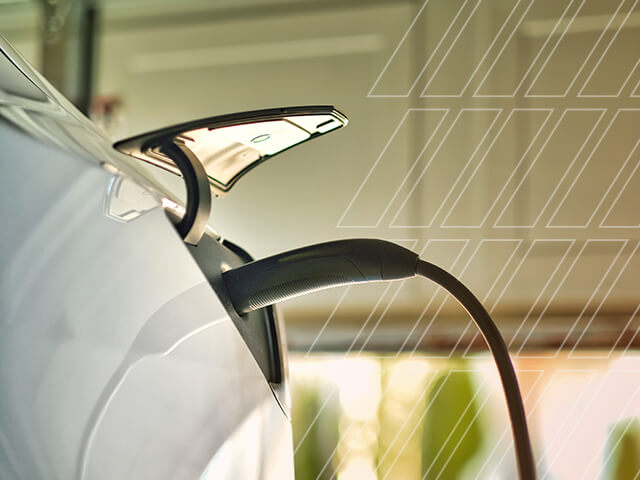ACV facts & figures

Electric vehicles (EVs) have become increasingly common to see on the road. There are numerous electric vehicle types, many of which are available used for under $20,000.
Let's examine the different types of car batteries and their significant technological advancements over time.
EV Battery Technology
Hybrid-electrics are gas- and battery-powered EVs, and they don't plug into commercial or non-commercial charging stations. Plug-in hybrids are versatile, which appeals to car buyers who prioritize the eco-consciousness of an EV but also the quick refueling of gas-powered vehicles for longer trips.
All have one thing in common: They rely on advanced electric car battery technology, which is rapidly evolving.
How Do EV Batteries Work?
EV batteries consist of hundreds to thousands of individual cells, each capable of storing electrical energy. Different chemical reactions allow the cells to store energy and then discharge it to power the vehicle, depending on the battery type1.
Types of EV Batteries
EV batteries are predominantly lithium-ion (Li-Ion) and available in various materials.
Nickel-cobalt-aluminum (NCA) and Nickel-manganese-cobalt (NMC)
These batteries are typically used in higher-end vehicles. The use of cobalt provides better energy density and thermal stability. This translates into a battery type that lasts longer and charges faster.
Lithium-iron-phosphate (LFP)
These batteries use more cells to reach the same level of power as NCA and NMC batteries. However, LFPs are a more economical option. They lack nickel and cobalt, making them less expensive than their NCA and NMC counterparts. Not only are LFPs less costly, but they're also long-lasting and less likely to catch on fire in the event of a short circuit or high impact2.
Nickel-metal-hydride (NiMH)
Older hybrids primarily use these batteries. They generally last longer than Li-Ion but are more expensive, produce a lot of heat, and are heavier than modern alternatives. These reasons could contribute to why modern hybrids typically don't use NiMH batteries3.
Battery Software
EV batteries must be kept at 70 degrees Fahrenheit1 to maximize performance, avoid overcharging and oxidation, and minimize fire risks. Battery management system (BMS) software monitors temperatures. If a battery gets too hot, some BMS can circulate coolant to drop the battery's temperature. Likewise, a BMS may be able to use battery or plug-in energy to warm up the battery in cold temperatures. BMS is a key component of EV battery technology.
EV Battery Advancements
The future of EV battery technology is bright! Here are just a few examples of upcoming developments for EV batteries.
Solid State Batteries
Solid-state batteries (SSBs) improve upon Li-Ion battery performance. Solid-state batteries swap liquid chemicals with a solid electrolyte, allowing them to operate safely at higher temperatures. Solid-state batteries are lighter compared to other EV batteries, which ultimately leads to longer ranges for EVs.
SSBs do have drawbacks. They are tougher to produce and require expensive materials, so it may take some time for solid-state batteries to become the norm. When they do reach market, range anxiety (the fear of losing power before reaching a charging station) is expected to be significantly reduced4.
Lithium Manganese-Rich (LMR) Prismatic Battery Cells
Through a partnership, GM and LG Energy Solutions are developing LMR battery cells.
To make the cells, developers take an existing battery type and remove many of its negatives. The GM and LG-produced LMR batteries have 50% fewer parts, with a 33% increase in energy density (storage)5.
EV Battery Charging Speeds
One challenge of EVs is the need to wait for charging. One solution is being used in China. There, drivers utilize battery swapping stations that remove an empty battery and swap it with a charged one. As reported in the npj Quantum Information journal, physicists are pioneering another, using scientific principles to significantly speed up battery charge rates. That's good, because EVs with significantly fast charge rates eliminate a buying concern customers have6,7.
How Dealers Can Take Advantage of EVs
When your sales team beefs up their knowledge of electric vehicles and battery types, they'll be able to expertly answer customer questions. This puts your dealership in a better position to build trust and a loyal customer base.
Dealerships ready to stock their lots with high-quality used vehicles using the latest EV battery technology should look no further than ACV Auctions. ACV carries a wide variety of electric cars, trucks, and more. Sign up with ACV Auctions today.
Sources
- Voelcker, J. (29 July 2024). Electric-Vehicle Battery Basics. Car and Driver. Retrieved June 22, 2025, from https://www.caranddriver.com/features/a43093875/electric-vehicle-battery/
- Duléry, S. (12 February 2024). Electric vehicle batteries: types and characteristics. Electromaps. Retrieved June 22, 2025, from https://www.electromaps.com/en/blog/electric-vehicle-batteries-types-characteristics
- Nichols, D. (12 September 2024). Different Types of EV batteries. GreenCars. Retrieved June 22, 2025, from https://www.greencars.com/greencars-101/different-types-of-ev-batteries
- Hertz, J. (9 January 2025). Will 2025 Be a ‘Solid’ Year for EV Batteries? EE Power. Retrieved June 22, 2025, from https://eepower.com/tech-insights/will-2025-be-a-solid-year-for-ev-batteries/#
- Wayland, M. (13 May 2025). GM unveils new ‘groundbreaking’ EV battery tech, aims to be first to market. CNBC. Retrieved June 22, 2025, from https://www.cnbc.com/2025/05/13/gm-new-ev-battery-tech.html
- Liu, I. (/6 May 2025) A new fully charged EV battery in five minutes: Are China’s swap stations the future of electric cars? BBC. Retrieved June 22, 2025, from https://www.bbc.com/future/article/20250506-are-chinas-swap-stations-the-future-of-electric-cars
- Hall, H. (23 January 2025) Battery Buzz: 5 breakthroughs to watch in 2025. R&D World. Retrieved June 22, 2025, from https://www.rdworldonline.com/battery-buzz-5-breathroughs-to-watch-in-2025/












